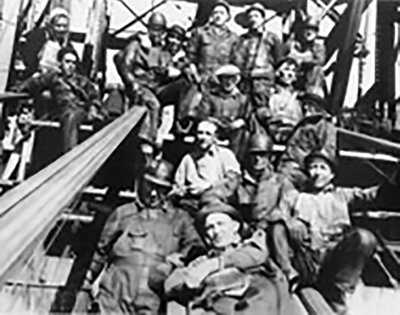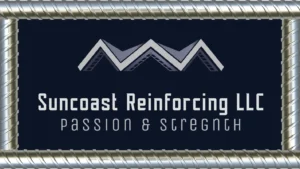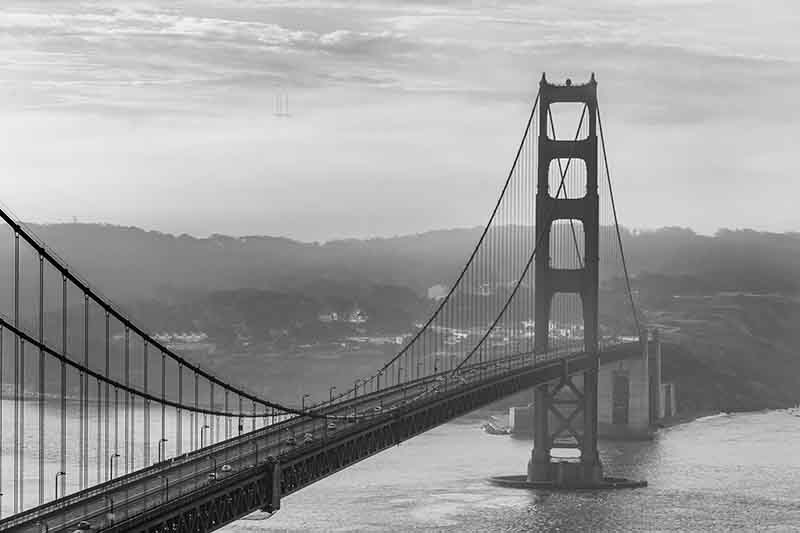
A group of bridge workers pose for camera, Photo by Ed Ashoff
From PBS/American Experience —
It took much more than a clever engineer and a relentless promoter to build the Golden Gate Bridge. The bridge effort enlisted men by the hundreds to do the back-breaking, and routinely dangerous labor.
Available jobs
Workers built the bridge during the worst depression on the 20th century — years when Americans stood in breadlines and 1 in 4 were unemployed. The men were happy to be on the bridge and to have a job — any job.
Required to use men from local unions, contractors had to contend with the fact that few ironworkers lived in San Francisco at the time. Word spread fast that jobs were available.
“When they were asked, ‘Listen, have you ever been an ironworker?’ ” remembered a worker’s son, Skip Lambert, “(They’d say) ‘Yeah, I was born an ironworker. I been an ironworker all my life.'”
Farmers and taxicab drivers
Hiring was handled entirely through the Ironworkers Union, Local 377. Out-of-town job seekers bought addresses and Social Security numbers from city residents in order to meet the residence requirements.
Workers came from all different backgrounds and occupations. Former farmers, clerks, and taxicab drivers became high steel men. Before taking a job as an ironworker on the bridge, 25-year-old Slim Lambert had been a cowboy, a stevedore, and a lumberjack.
Good money
When construction started, in January 1933, union wages ranged from $4 to $11 per day (about $45 to $125 per day in 2004 dollars).
Workers clocked in when they reached their work sites — the 30- to 40-minute climb was on their own time. Despite the obvious risks, a job on the bridge was considered a plum. Cable supervisor Charles Kring recalled, “There was always somebody waiting at the base of the tower for someone to fall off so they’d get a job.”
Anchorages
The first workers excavated three and a quarter million cubic feet of dirt and poured seemingly endless amounts of concrete for the bridge’s two anchorages.
Twelve stories high, the anchorages were designed to secure 63 million pounds — twice the pull of the bridge’s main cables. Workers stood in the anchorage pit while a long tube called an “elephant trunk” delivered wet concrete down to their level.
The men labored to mix the concrete as it was poured, to remove any air pockets.
Up high
The first 745-foot tower began to rise on the Marin shore in November 1933. Prefabricated sections were fit into place and then joined together by four-man rivet gangs.
The heater was the boss; he brought rivets to the right temperature on a small forge, then tossed them to catchers with metal cans.
“They went ‘Zing’ just like a bullet … and you best catch it, and take it out, and you had to put it in fast,” recalled ironworker Walter Vestnys. Once both towers were complete, in June 1935, workers built catwalks and started spining the cables. Roadway work would not begin until June 1936.
Nerves of steel
Workers had to be fearless to climb the high steel in the first place, but the local weather called for truly superhuman nerve.
“The fog would come in and go out, come in, go out, all day long,” described Vestyns. “When it’s wet, the iron is just like ice … pretty chancy when you have to walk around so much.”
Worker’s son Skip Lambert described the windy conditions, saying, “a gust could come along and literally blow you right off.”
The Halfway to Hell Club
Joseph Strauss implemented safety innovations including a safety net cantilevered out underneath the entire bridge during roadway construction.
Nineteen men would fall into it, cheating death and proclaiming themselves the Halfway to Hell Club.
The net boosted workers’ morale and became an attraction for showboats and club wannabes, who had to be ordered not to jump into it on purpose.
Down below
The birdge’s underwater workers faced some of the toughest challenges. Divers were employed to set explosives and blast away rock for seating the south tower’s supports.
Each dive had to take place in a narrow window of time — as little as an hour and 15 minutes — due to treacherous tidal currents. “If you go out to the bridge site,” comments civil engineer Mark Ketchum, “you can see the waves crashing over the south shore.
“And those waves are only the surface manifestation of a big energy pump underneath the water.” Sometimes, divers had to be recalled before they were ready to resurface, and decompression sickness could set in.
Building a landmark
Workers completed the Golden Gate Bridge in 1937. When the immediate landmark opened to the public, few of the men who had built it attended the celebration.
Most of them figured they had seen enough of the structure.
But one of the workers who went was Harold McClain.
“I was in the parade, and I walked across the bridge,” he said. “It was never just a job to me. I loved the work.”
Worksite safety and accidents
In the era of the Golden Gate Bridge’s construction, workmen knew a grim rule of thumb: On average, one worker would be killed for every million dollars spent on a high-steel construction project.
Image-conscious chief engineer Josepf Strauss wanted his project to be the exception. Strauss invested hundreds of thousands of dollars — Depression-era dollars — to improve equipment and safety standards for his workers.
Hardhats
Russell Cone, resident engineer, supervised safety procedures for all workers.
Cone made sure hard hats were worn at all times, since most workmen were injured by errant flying objects. Drinking alcohol or stunting — at any height — was grounds for immediate dismissal.
Cone was a tough enforcer of the safety rules. But the most innovative safety feature at the Golden Gate site was yet to come.
A safety net
In 1936, when delays slowed construction, Strauss invested over $130,000 in a novel safety feature: a vast net — similar to a circus net — suspended under the bridge.
The safety net extended 10 feet wider than the bridge’s width and 15 feet further than the roadway’s length. It gave workers an abiding sense of security as they moved more freely — and quickly — across the slippery, half-constructed steel.
“There’s no doubt the work went faster because of the net,” said Lefty Underkoffler, a Golden Gate bridgeman. Some workers were positively giddy about the innovation, so much so that they had to be threatened with dismissal so they wouldn’t dive into the net for thrills.
The accident
The net was soon considered a large success in its own right. It was patented by its manufacturer, J. L. Stuart Company.
But the morning of Feb. 16, 1937, would prove that the net was not infallible.
A crew of eleven men were working on a stripping platform close to the north tower, while two men in the net below scraped away debris. In a flash, the west side of the platform gave way.
The five-ton structure hung crazily from the bridge, tilting its panicked load of workers toward the water hundreds of feet below. One worker, Tom Casey, lunged and grabbed onto a bridge beam, where he dangled until he was rescued.
Deadly plummet
One set of scaffold wheels had escaped its support rail, and the unbalanced weight quickly released the other two sets. The whole mechanism collapsed into the net, which held it — but only momentarily.
The sound of the net tearing, according to witnesses, was like “the crack of a machine gun” or “the rip of a picket fence splintering.” The men, the wood, and the net plummeted 220 feet into the water — the height of a 22-story building.
Ten men killed
Of the 12 men who fell to the water, two survived.
One of them was the foreman of the stripping crew, Slim Lambert.
“As I was falling, a piece of lumber fell on my head. I was almost unconscious. Then the icy water of the channel brought me to,” said Lambert.
He was 26 at the time and, fortunately, a strong swimmer. He struggled to free himself from the tangles of the net underwater.
Lambert suffered a broken shoulder, several ribs, and several neck vertebrae, but he lived to tell the tale. In a single catastrophe, the project’s near-perfect safety record was obliterated.
Suncoast Reinforcing is hiring!
If you’re looking for work, contact Suncoast Reinforcement for information about current openings.
We’re nearly always hiring skilled ironworkers, supervisors and helpers.


0 Comments